Xianfu Lei
SCA-LLM: Spectral-Attentive Channel Prediction with Large Language Models in MIMO-OFDM
Sep 09, 2025Abstract:In recent years, the success of large language models (LLMs) has inspired growing interest in exploring their potential applications in wireless communications, especially for channel prediction tasks. However, directly applying LLMs to channel prediction faces a domain mismatch issue stemming from their text-based pre-training. To mitigate this, the ``adapter + LLM" paradigm has emerged, where an adapter is designed to bridge the domain gap between the channel state information (CSI) data and LLMs. While showing initial success, existing adapters may not fully exploit the potential of this paradigm. To address this limitation, this work provides a key insight that learning representations from the spectral components of CSI features can more effectively help bridge the domain gap. Accordingly, we propose a spectral-attentive framework, named SCA-LLM, for channel prediction in multiple-input multiple-output orthogonal frequency division multiplexing (MIMO-OFDM) systems. Specifically, its novel adapter can capture finer spectral details and better adapt the LLM for channel prediction than previous methods. Extensive simulations show that SCA-LLM achieves state-of-the-art prediction performance and strong generalization, yielding up to $-2.4~\text{dB}$ normalized mean squared error (NMSE) advantage over the previous LLM based method. Ablation studies further confirm the superiority of SCA-LLM in mitigating domain mismatch.
Pinching-Antenna-Assisted Index Modulation: Channel Modeling, Transceiver Design, and Performance Analysis
Jul 03, 2025Abstract:In this paper, a novel pinching-antenna assisted index modulation (PA-IM) scheme is proposed for improving the spectral efficiency without increasing the hardware complexity, where the information bits are conveyed not only by the conventional M-ary quadrature amplitude modulation (QAM) symbols but also by the indices of pinching antenna (PA) position patterns. To realize the full potential of this scheme, this paper focuses on the comprehensive transceiver design, addressing key challenges in signal detection at the receiver and performance optimization at thetransmitter. First, a comprehensive channel model is formulated for this architecture, which sophisticatedly integrates the deterministic in-waveguide propagation effects with the stochastic nature of wireless channels, including both largescale path loss and small-scale fading. Next, to overcome the prohibitive complexity of optimal maximum likelihood (ML) detection, a low-complexity box-optimized sphere decoding (BOSD) algorithm is designed, which adaptively prunes the search space whilst preserving optimal ML performance. Furthermore, an analytical upper bound on the bit error rate (BER) is derived and validated by the simulations. Moreover, a new transmit precoding method is designed using manifold optimization, which minimizes the BER by jointly optimizing the complex-valued precoding coefficients across the waveguides for the sake of maximizing the minimum Euclidean distance of all received signal points. Finally, the simulation results demonstrate that the proposed PA-IM scheme attains a significant performance gain over its conventional counterparts and that the overall BER of the pinching-antenna system is substantially improved by the proposed precoding design.
A Gradient Meta-Learning Joint Optimization for Beamforming and Antenna Position in Pinching-Antenna Systems
Jun 14, 2025Abstract:In this paper, we consider a novel optimization design for multi-waveguide pinching-antenna systems, aiming to maximize the weighted sum rate (WSR) by jointly optimizing beamforming coefficients and antenna position. To handle the formulated non-convex problem, a gradient-based meta-learning joint optimization (GML-JO) algorithm is proposed. Specifically, the original problem is initially decomposed into two sub-problems of beamforming optimization and antenna position optimization through equivalent substitution. Then, the convex approximation methods are used to deal with the nonconvex constraints of sub-problems, and two sub-neural networks are constructed to calculate the sub-problems separately. Different from alternating optimization (AO), where two sub-problems are solved alternately and the solutions are influenced by the initial values, two sub-neural networks of proposed GML-JO with fixed channel coefficients are considered as local sub-tasks and the computation results are used to calculate the loss function of joint optimization. Finally, the parameters of sub-networks are updated using the average loss function over different sub-tasks and the solution that is robust to the initial value is obtained. Simulation results demonstrate that the proposed GML-JO algorithm achieves 5.6 bits/s/Hz WSR within 100 iterations, yielding a 32.7\% performance enhancement over conventional AO with substantially reduced computational complexity. Moreover, the proposed GML-JO algorithm is robust to different choices of initialization and yields better performance compared with the existing optimization methods.
Safeguarding Next Generation Multiple Access Using Physical Layer Security Techniques: A Tutorial
Mar 25, 2024



Abstract:Driven by the ever-increasing requirements of ultra-high spectral efficiency, ultra-low latency, and massive connectivity, the forefront of wireless research calls for the design of advanced next generation multiple access schemes to facilitate provisioning of these stringent demands. This inspires the embrace of non-orthogonal multiple access (NOMA) in future wireless communication networks. Nevertheless, the support of massive access via NOMA leads to additional security threats, due to the open nature of the air interface, the broadcast characteristic of radio propagation as well as intertwined relationship among paired NOMA users. To address this specific challenge, the superimposed transmission of NOMA can be explored as new opportunities for security aware design, for example, multiuser interference inherent in NOMA can be constructively engineered to benefit communication secrecy and privacy. The purpose of this tutorial is to provide a comprehensive overview on the state-of-the-art physical layer security techniques that guarantee wireless security and privacy for NOMA networks, along with the opportunities, technical challenges, and future research trends.
Two-Timescale Transmission Design for Wireless Communication Systems Aided by Active RIS
Oct 25, 2022

Abstract:This paper considers an active reconfigurable intelligent surface (RIS)-aided communication system, where an M-antenna base station (BS) transmits data symbols to a single-antenna user via an N-element active RIS. We use two-timescale channel state information (CSI) in our system, so that the channel estimation overhead and feedback overhead can be decreased dramatically. A closed-form approximate expression of the achievable rate (AR) is derived and the phase shift at the active RIS is optimized. In addition, we compare the performance of the active RIS system with that of the passive RIS system. The conclusion shows that the active RIS system achieves a lager AR than the passive RIS system.
Cognitive Semantic Communication Systems Driven by Knowledge Graph
Feb 24, 2022

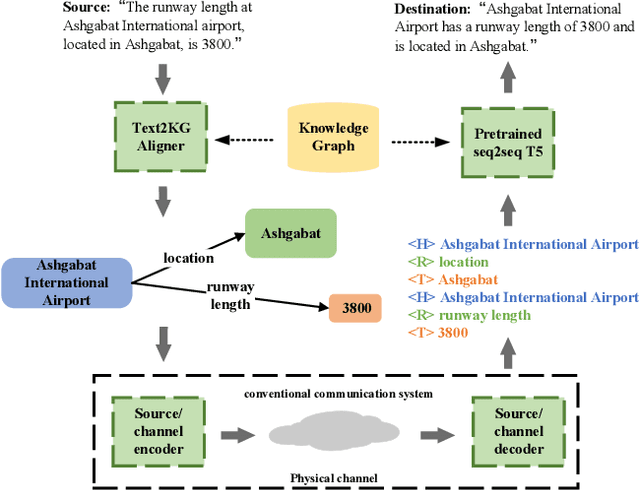

Abstract:Semantic communication is envisioned as a promising technique to break through the Shannon limit. However, the existing semantic communication frameworks do not involve inference and error correction, which limits the achievable performance. In this paper, in order to tackle this issue, a cognitive semantic communication framework is proposed by exploiting knowledge graph. Moreover, a simple, general and interpretable solution for semantic information detection is developed by exploiting triples as semantic symbols. It also allows the receiver to correct errors occurring at the symbolic level. Furthermore, the pre-trained model is fine-tuned to recover semantic information, which overcomes the drawback that a fixed bit length coding is used to encode sentences of different lengths. Simulation results on the public WebNLG corpus show that our proposed system is superior to other benchmark systems in terms of the data compression rate and the reliability of communication.
Dilated Convolution based CSI Feedback Compression for Massive MIMO Systems
Jun 08, 2021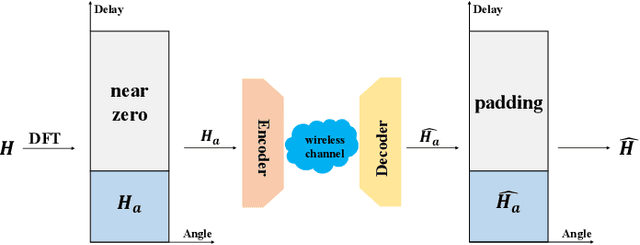
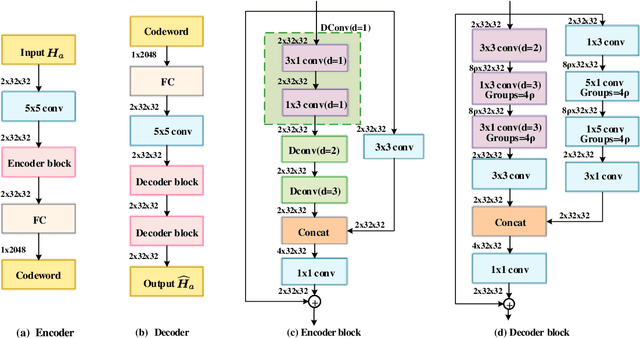
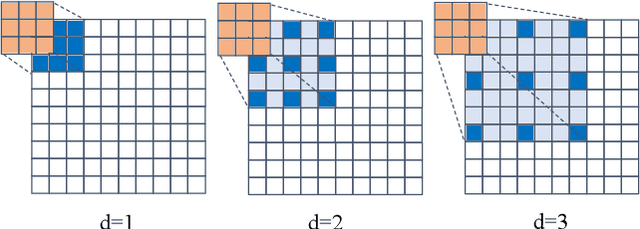
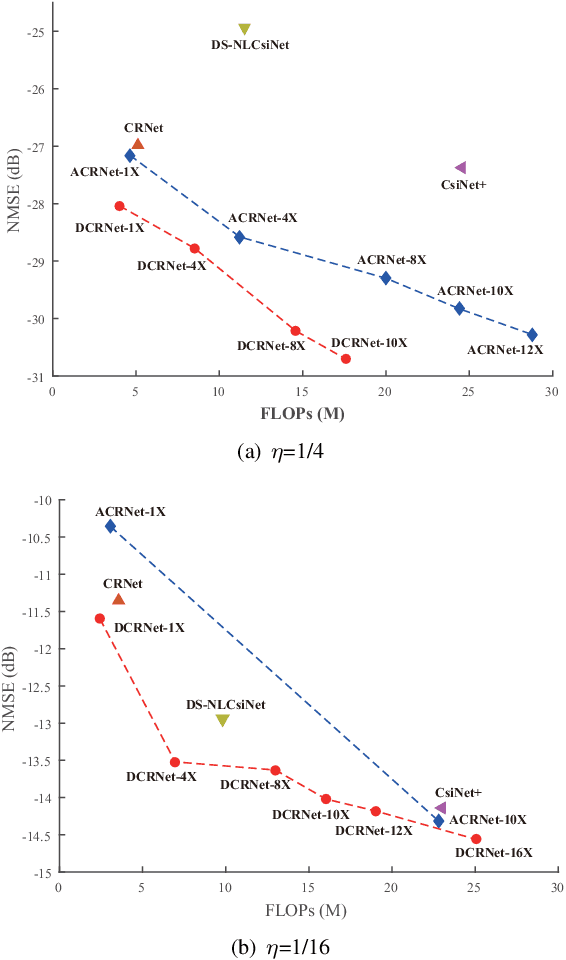
Abstract:Although the frequency-division duplex (FDD) massive multiple-input multiple-output (MIMO) system can offer high spectral and energy efficiency, it requires to feedback the downlink channel state information (CSI) from users to the base station (BS), in order to fulfill the precoding design at the BS. However, the large dimension of CSI matrices in the massive MIMO system makes the CSI feedback very challenging, and it is urgent to compress the feedback CSI. To this end, this paper proposes a novel dilated convolution based CSI feedback network, namely DCRNet. Specifically, the dilated convolutions are used to enhance the receptive field (RF) of the proposed DCRNet without increasing the convolution size. Moreover, advanced encoder and decoder blocks are designed to improve the reconstruction performance and reduce computational complexity as well. Numerical results are presented to show the superiority of the proposed DCRNet over the conventional networks. In particular, the proposed DCRNet can achieve almost the state-of-the-arts (SOTA) performance with much lower floating point operations (FLOPs). The open source code and checkpoint of this work are available at https://github.com/recusant7/DCRNet.
A 3D Non-stationary MmWave Channel Model for Vacuum Tube Ultra-High-Speed Train Channels
Feb 09, 2021
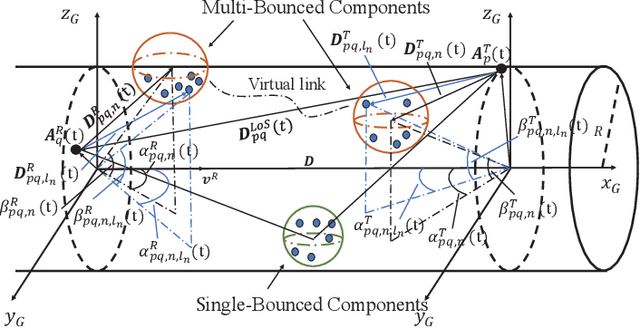

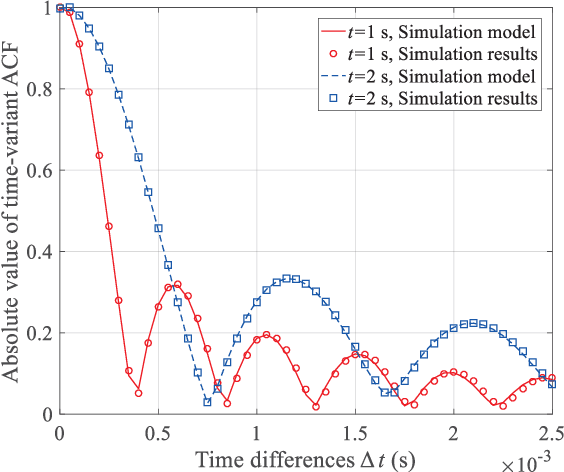
Abstract:As a potential development direction of future transportation, the vacuum tube ultra-high-speed train (UHST) wireless communication systems have newly different channel characteristics from existing high-speed train (HST) scenarios. In this paper, a three-dimensional non-stationary millimeter wave (mmWave) geometry-based stochastic model (GBSM) is proposed to investigate the channel characteristics of UHST channels in vacuum tube scenarios, taking into account the waveguide effect and the impact of tube wall roughness on channel. Then, based on the proposed model, some important time-variant channel statistical properties are studied and compared with those in existing HST and tunnel channels. The results obtained show that the multipath effect in vacuum tube scenarios will be more obvious than tunnel scenarios but less than existing HST scenarios, which will provide some insights for future research on vacuum tube UHST wireless communications.
 Add to Chrome
Add to Chrome Add to Firefox
Add to Firefox Add to Edge
Add to Edge